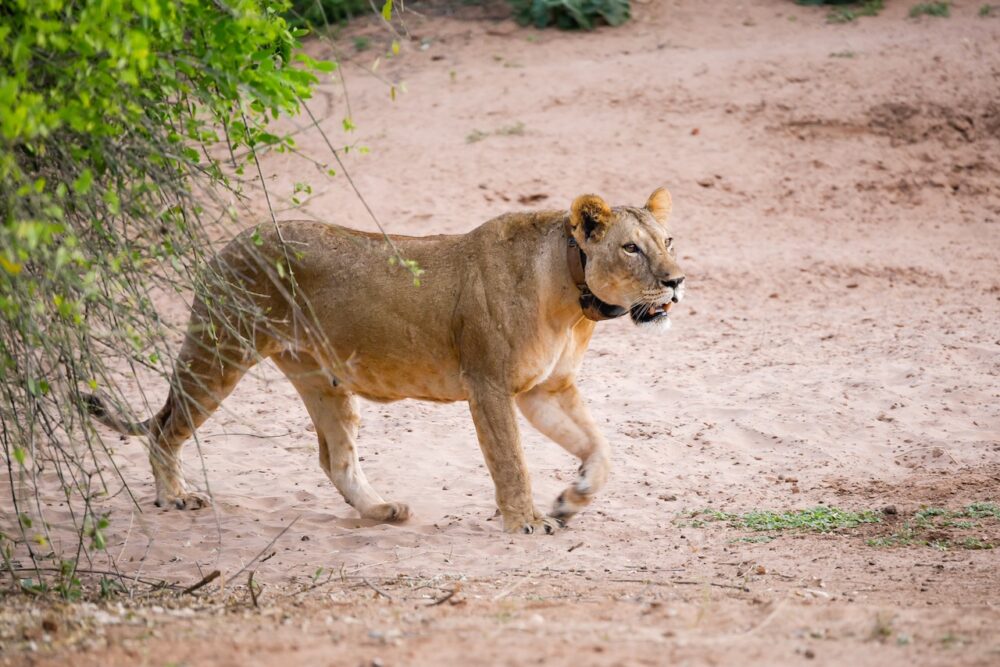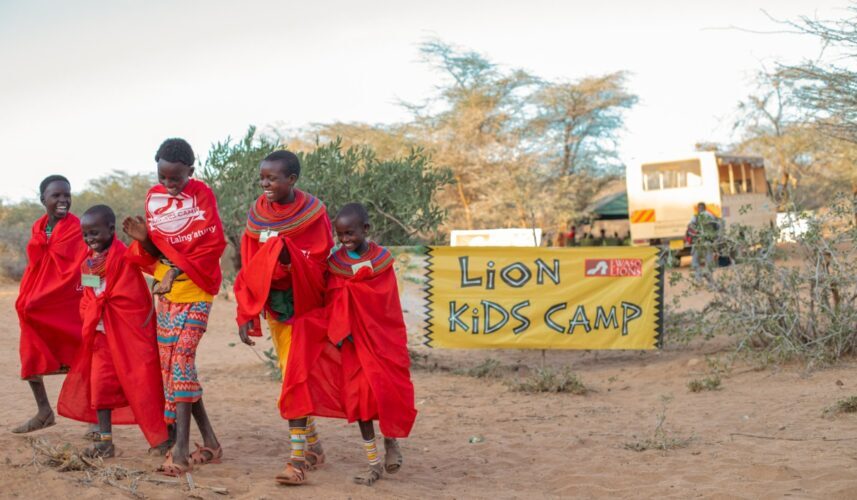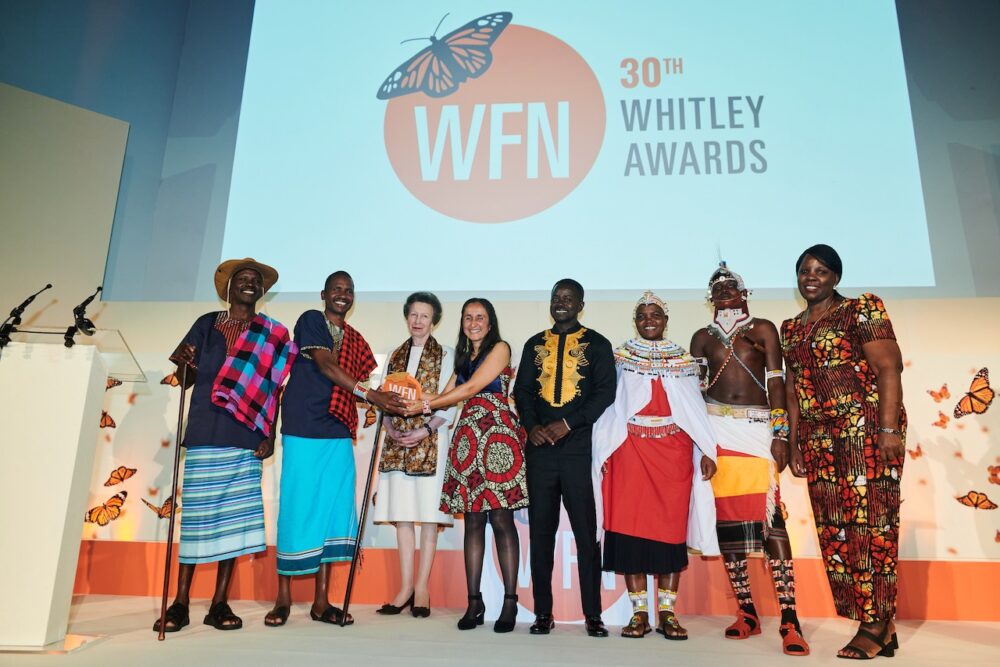Long days, harsh conditions, intense disputes, and sometimes heartache – lion conservation is hard work. And on some days it seems the challenges are insurmountable and it feels like we’re alone. Fortunately, this last part is not the case.
In Mozambique, the Niassa Lion Project is also working tirelessly with local people to conserve the lion population and improve livelihoods in the vast wilderness of Niassa National Park. Some of our staff recently spent a few days in Mozambique with the Niassa team to see their conservation programmes, exchange ideas, and discuss challenges. The Niassa team had visited us in Kenya last year and the outcome was fantastic. Both Niassa Lion Project and Ewaso Lions are Partners in the Wildlife Conservation Network, who helped support this exchange.

Members from Ewaso Lions and Niassa Lion Project reunite in Mozambique. From left to right: Yesalai, Samuel, Jeneria, Euzebio and Moses.
Upon arrival in Niassa National Park, Jeneria, Yesalai, Moses, and Shivani were warmly greeted by Colleen and Keith Begg, who run the Niassa Lion Project. On the first day we climbed Ncupola and Mapili mountains and tracked some lions only to find that they were far away in an area which was inaccessible. We saw sable, kudu, warthog, impala and much more during our drive through the concession area. It was so beautiful – we couldn’t believe how much grass there was, and gazed in awe at the tall baobabs and other huge trees.
Later in the day we visited Mariri the beautiful Mariri Environmental Centre – which will eventually house children and adults for wildlife experiences and skills training. We went back out with Euzebio who was able to track the lioness Flavia and her pride of seven across from the Mbamba village. Fabio, a young male, stayed close to the car and we practiced drawing whisker spots of the male.
We joined Euzebio and Samuel, two incredible trackers who monitor lions daily in the stunning Niassa wilderness.
One of our favorite moments was when we were on top of Ncupola mountain, taking in the beautiful scenery, and Jeneria kept asking where Niassa Park’s boundary was. Coming from Samburu, where you can generally see the boundaries of the reserves and conservancies, it took us a while to understand the scale of Niassa and how large it is.
On our second day, we visited the chiefs and community leaders from the Mbamba village. We learned how their livestock breeding, conservation agriculture and bee-hive fence programmes are helping improve the livelihoods of local people which in turn strengthens support for lion conservation. We spoke with the chiefs about conservation and its challenges, relating to theirs in Niassa.
We were excited to meet the livestock breeding group – a dedicated, passionate group who are breeding livestock to improve food security – especially Mama Rabbit, who loves her rabbits so much that when one was sick she was worried for days! That night, we saw 11 wild dogs outside the Mariri Environmental Centre at night – what a way to end the day.

The livestock breeding group is so passionate about their livestock. We will never forget one fearless lady in particular who loves her rabbits!
On the third day Jeneria, Yesalai and Moses accompanied Pedro, Muemedi and the anti-poaching patrol team. They patrolled through Niassa’s thick wilderness and searched for poachers’ tracks in tall grass, which was very new for our team who are not used to seeing grass! They slept in a lugga near the boundary of the community area and the concession and returned the following day excited after 2 days in the field.
During our last evening in Niassa, we gathered at the Mariri Environmental Centre and reunited with community members from Mbamba. We gave presentations on our work in Samburu and the day ended with a lovely dance from the Mbamba ladies. It was fantastic to see this and our Samburu team armed with cameras, took lots of photos and videos to show the team back home. We drove 10 hours back to Pemba the following day, ready for our flight back to Nairobi on the 12th.

Jeneria speaks to the community about conservation, just before the ladies from Mbamba village danced.
Jeneria recounts his trip and emphasizes how impressed he was by his visit to Niassa. “They never lose hope, and that gives me hope,” he says. “Knowing Euzebio, Pedro and the rest, and seeing what they are trying to achieve, makes me stronger when I return to Samburu. I want to achieve many things and now I have so many ideas of what to tell my community”.
Colleen wrote a very touching note that summed up the trip perfectly: “It is impossible to express the value of this visit. We learned, laughed and shared and it made us all better conservationists. You had some first’s – the sea, coconuts, planes, presenting in Swahili, buffalo, tall grass, canoes and hula-hoops and swings. We couldn’t get you to try fish! We learned so much from you. When we watched the concentration of everyone from the community listening to your presentations, learning from you and the honest way you expressed what conservation means and why it is important, we knew that this was the way that conservation will go forward. You helped fertilize a seed we had planted and we need it to grow. You helped us hugely by sharing your experiences. I honestly believe that this is the way to do community based conservation. You helped our local conservationists feel less alone, that they were part of a growing movement and that they have friends also doing conservation in the face of human wildlife conflict and poverty. It made them less isolated, and they could talk through their frustrations and know they are not alone.”

Colleen Begg at her desk at Nculi camp. Even with malaria and Chikungunya, a virus, Colleen doesn’t stop working. Her dedication to the lions and people of Niassa is truly inspiring.
It is really hard to capture and express the value of the trip. Knowing we are not alone in our work, and the advice we got from Keith and Colleen was so inspirational. And the value for our teams to be together is impossible to articulate. Seeing their faces as they chatted and discussed their work, laughed, got worked up over challenges, and experienced new things – this was amazing. These trips mean so much to our teams and knowing they are not alone in their work gives everyone hope, strength and encouragement.
Kenya and Mozambique are very different countries, but both countries have lion populations that are at risk. By collaborating together, we are hopeful that we can come up with solutions that work in both regions, and lead to more efficient, cost effective, and swifter lion conservation efforts.
> Visit the Niassa Lion Project’s website www.niassalion.org
> See more photos from the trip on our Facebook page
> Read about the Niassa team’s visit to Kenya last year

Euzebio, Moses, Yesalai, Hortensio and Jomba from both teams – they have become a great group of friends.

Keith, Colleen, Ella, Finn, Euzebio, Oscar, Batista, and the rest of the Niassa team – you are all our heroes. Thank you for all you do!









